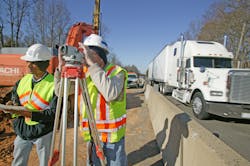Solving revenue gap riddle key post-election challenge for transportation
While one of the most pressing issues facing President Barack Obama following his re-election victory is how to deal with the impending “fiscal cliff” of tax increases and spending cuts due to automatically take effect Jan. 1 next year, another “fiscal cliff” of sorts awaits his administration and Congress in 2014 as the short-term highway funding bill passed in July this year expires.
“When MAP-21 [Moving Ahead for Progress in the 21st Century] ends in 2014, transportation funding is going to face its own ‘fiscal cliff’ of sorts,” Peter J. “Jack” Basso, director of program finance and managementfor the American Association of State Highway and Transportation Officials (AASHTO) told Fleet Owner.
Basso explained that the Congressional Budget Office (CBO) projects that massive cuts in both highway and transit funding will occur in fiscal year (FY) 2015 if MAP-21 expires and nothing replaces it. He noted that the CBO projects highway funding would be slashed to $4.5 billion in FY 2015 from $40 billion annually right now, with transit program funding shrinking to $3.5 billion from $11 billion.
While Basso stressed that highway trust fund revenues would recover in FY 2016 and beyond, they’d only reach some $34 billion annually – not nearly enough to maintain and expand the nation’s transportation system, according to AASHTO’s research.
Indeed, a report issued by the group two years ago indicates the freight industry alone requires a sharp increase in infrastructure funding as overall freight demand is expected to double in the next four decades, from 15 billion tons in 2010 to 30 billion tons by 2050.
Freight carried by trucks will increase 41% and by rail by 38% from today’s quantities, according to AASHTO’s analysis, with traffic on the interstate highway system increasing by 150% – all while interstate capacity expanded by just 15% between 1980 and 2006.
“We’ve known about this revenue problem for a long time, and there’s been no lack of information on the available options to fix it – from raising fuel taxes and other user fees to expanding options for highway tolls,” Basso noted. “But the problem remains political: how to increase taxes, user fees, and other methods to raise revenues.”
He did point out that one of the great successes of MAP-21 revolves around mandated freight transportation planning – resulting in the formation of a new Freight Policy Council within the U.S. Department of Transportation (DOT) earlier this year.
Yet even that success is limited, said Basso, if the funding issue isn’t addressed. “MAP-21 really set the stage for more coordinated freight policy between the federal government and the states; it was a real breakthrough, making freight needs more visible,” he explained. “But all such planning returns to the same point: where will the money to fund it come from?”
As a result, state governments are now stepping in more forcefully to try and fill such “revenue gaps” where transportation is concerned, noted Basso – and he expects such activity to only increase in the months and years ahead.
By his count, eight states have already raised fuel taxes to provide transportation funding, while several others have either added or are trying to add tolls to the highway system to fund new construction. “This is being done at the state level; not by the feds,” Basso stressed. “That’s another benefit of MAP-21; it opened the door to allow the addition of tolls to existing highways if those revenues are earmarked to fund new [roadway] construction.”
Yet he cautioned that relying on states for such “revenue generation” initiatives in order to pay for transportation infrastructure needs is an uneven prospect at best, as many rural states – such as Montana – simply don’t have large enough populations or highway traffic to generate sufficient funds.
“Montana is a good example because it’s two-thirds the size of Alaska with maybe just over 1 million residents,” Basso explained. “Such sparsely populated states simply don’t have revenue base to maintain and expand transportation infrastructure on their own.”
Indeed, roughly about one-third of the states in AASHTO’s estimation can’t afford to pay for highway infrastructure on their own. “That’s why you need both the federal government and state governments to work together to support the interstate highway system,” he said.
Even at the state level, however, trying to raise revenues -- such as boosting fuel taxes -- to fund transportation initiatives is anything but an easy sell.
For example, Maryland’s Governor Martin O'Malley lost his attempt to apply that state's 6% sales tax to gasoline fuel earlier back in April – an effort that was designed to generate $613 million-a-year to fund backlogged road and transit projects.
“There just doesn’t seem to be any appetite for such funding efforts right now, either at the state or federal level,” said AASHTO’s Basso. “That’s going to be the real challenge going forward from here: how do we get the transportation revenue problem fixed.”
About the Author
Sean Kilcarr
Editor in Chief
Sean Kilcarr is a former longtime FleetOwner senior editor who wrote for the publication from 2000 to 2018. He served as editor-in-chief from 2017 to 2018.
